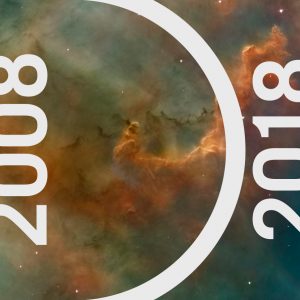 [TORONTO] In May 2018, the Dunlap Institute for Astronomy & Astrophysics at the University of Toronto celebrates ten years of innovation in astronomical technology and instrumentation, astronomical research, training the next generation of astronomers, and sharing the excitement of astronomy with the public.
[TORONTO] In May 2018, the Dunlap Institute for Astronomy & Astrophysics at the University of Toronto celebrates ten years of innovation in astronomical technology and instrumentation, astronomical research, training the next generation of astronomers, and sharing the excitement of astronomy with the public.
“The Dunlap Institute is strongly rooted in traditions associated with the Dunlap name,” says the U of T’s Prof. Peter Martin, who was instrumental in bringing the Institute to life in 2008. “The Institute has touched many, nationally and internationally, through its innovative and ambitious research, training, and education programs. What a wonderful start over the first decade.”
In 2008, the Dunlap became the third member of the University’s astronomy group, which already included the Department of Astronomy & Astrophysics and the Canadian Institute for Theoretical Astrophysics (CITA). The Dunlap’s focus on astronomical technology and instrumentation complemented the existing expertise at U of T, thereby creating the leading centre for astronomical research in Canada, at the leading research university in the country. (The Centre for Planetary Sciences, U of T Scarborough, would become the fourth addition.)
View a Decade of Dunlap Institute Highlights Timeline >
Over the past decade, Dunlap scientists have been involved in developing innovative instruments that are now helping make discoveries on telescopes around the world. Many of those instruments are spectrographs, including the latest, the Wide Integral Field Infrared Spectrograph (WIFIS) which saw “first light” in late 2017.
The research themes of the Institute have grown over the decade to encompass optical, infrared and radio instrumentation; data analysis; Dark Energy; large-scale structure in the Universe; the Cosmic Microwave Background; the interstellar medium; galaxy evolution; cosmic magnetism; and time-domain science.
Today, Dunlap scientists play leading roles in Canadian and international collaborations which will be making ground-breaking discoveries for decades to come, including the Canadian Hydrogen Intensity Mapping Experiment (CHIME), the Dragonfly Telescope Array, the Square Kilometre Array (SKA), the Large Synoptic Survey Telescope (LSST), the South Pole Telescope (SPT), and many others.
Dunlap scientists also lead two major initiatives which received funding in 2017. The Canadian Initiative for Radio Astronomy Data Analysis (CIRADA) will help astronomers make discoveries using the growing flood of data from next generation telescopes. And, the Gemini Infrared Multi-Object Spectrograph (GIRMOS) will target very distant galaxies to help in the study of their formation and evolution.
Since 2012, one of the Dunlap’s flagship initiatives has been the annual Introduction to Astronomical Instrumentation Summer School, the brainchild of the Dunlap’s first director, Prof. James Graham. With instructors from the Dunlap, U of T, and other Canadian, U.S. and international institutions, the school attracts hundreds of applications every year from students from around the world. Along with many other training and mentoring initiatives, the Summer School delivers on the Institute’s training mandate.
To a growing number of non-scientists, the Dunlap Institute has meant a decade of exciting and inspiring public events. Over that period, the Dunlap has sparked a love of astronomy in tens of thousands through observing events to view the 2012 transit of the Venus, the 2015 Supermoon total lunar eclipse, and the 2017 solar eclipse. The public have also enjoyed connecting with U of T astronomers at events like the Dunlap’s Astronomy on Tap T.O. and at the Dunlap Prize Lecture in 2014 featuring Neil deGrasse Tyson.
As well, the Dunlap recently partnered with Discover the Universe to provide training and resources—in both French and English—for Canadian teachers to help them teach astronomy to their students.
“The first ten years of the Dunlap Institute were about figuring out what we want to do and then finding the right people to do it, “ says current Dunlap Director, Prof. Bryan Gaensler.
“We now have a clear plan for the future and a superb team on board, and we’re ready to put our foot to the floor. Brace yourselves for an upcoming torrent of new discoveries and talented young researchers.”
-30-
CONTACT INFORMATION:
Chris Sasaki
Communications Coordinator | Press Officer
Dunlap Institute for Astronomy & Astrophysics
University of Toronto
w: dunlap.utoronto.ca
p: 416-978-6613
e: csasaki@dunlap.utoronto.ca
w: dunlap.utoronto.ca
w: universe.ca
w: discovertheuniverse.ca
The Dunlap Institute for Astronomy & Astrophysics is committed to making its science, training and public outreach activities productive and enjoyable for everyone, regardless of gender, sexual orientation, disability, physical appearance, body size, race, nationality or religion.
###
